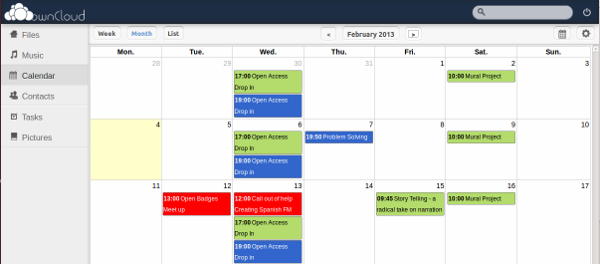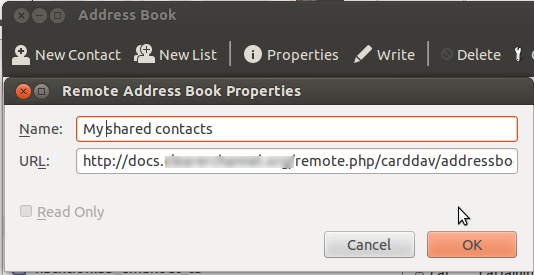Introduction
The main focus of ownCloud is storing and sharing documents, calendars and contacts in a secure way, which also embraces open standards.
There are two main reasons why you or your group may want to use ownCloud rather than a similar service like Google Docs or Dropbox. The first is that it offers more security for the files that you store, because you store them on your own server and can also encrypt them. The second reason is that by using ownCloud, you are supporting a more decentralized and less monitored internet. If you are uncomfortable about the level of data analysis and surveillance involved in signing up for corporate internet services, then ownCloud provides a very usable alternative.
About this manual
This manual is aimed to be a complement to the existing documentation at http://doc.owncloud.org. Our focus is to create beginner level help which is very visual, which includes screenshots of the interface and explains technical terms when they are used.
We also separate out the use of ownCloud by 'user level'. This means the guide begins with the tasks that are easiest to perform and gets progressively more technical. In this way new users can get started with this manual without being bogged down with advanced terminology.
The guide begins by focusing on using an ownCloud instance that someone else has installed. We cover simple admin of ownCloud via the web interface and follow that with detailed information on keeping information in-sync between devices. Only then in the ownCloud Server Admin section will there be a chapter on how to install it and begin to configure its use.
This manual was written by Donna Metzlar, Anna Morris and Mick Fuzz for FLOSS Manuals. The guide has been commissioned as part of the Human Rights Connect project of Internews Europe.
Overview of ownCloud’s features
Sharing files
Once you log in you will see an interface for sharing files under the Files menu on the left. You have options for uploading new files and folders, and for sharing these with other users on your ownCloud installation.

You can connect to online ownCloud folders without having to log in via your web browser. You can do this by downloading the ownCloud client and setting it up to share folders on your computer. This client works in a similar way to the popular Dropbox client. This piece of software can be installed on any desktop operating system – from Windows to Mac OS X to Linux – it is completely cross-platform.

Sharing calendars
You can use the shared calendar in the ownCloud web interface by clicking on the Calendar tab; or if you use Thunderbird as your email client you can connect to various calendars and display them under an Events tab in Thunderbird.

The calendars that ownCloud uses support the creation of 'tasks', making it suitable for simple project planning.
Sharing contacts
To use ownCloud as a shared repository of contacts, you can export your contacts as vCard (.vcf) files from your email service – from Thunderbird or Gmail, for example. You can then import these contacts into your ownCloud account. You can also use Thunderbird to manage your shared contacts by setting up a remote address book.

Using ownCloud as an alternative to Google Docs
While ownCloud works well as a file-sharing platform, it still lags behind in terms of real-time collaborative document editing compared to Google Docs. However: you could use Etherpad, an open-source collaborative editing program, to collectively edit the document, and then save it to ownCloud when you're finished.
Some background on ownCloud
ownCloud was started and is still maintained by the German open source software developer Frank Karlitschek. He first presented it at Camp KDE in 2010.
The name of the software partly explains the main goal of ownCloud. The term 'own' refers to running the service yourself, i.e. not being dependent on third-party services like Dropbox and WeTransfer. The term 'Cloud' refers to the service being on the internet as opposed to on your desktop computer or laptop. Because the software is running on a server on the internet the way to find or reach it is through an URL or web link.
Tiers of the cloud
Cloud computing refers to a range of different technologies and has been rather over-used in marketing. However, in this context we can understand it as technologies that take advantage of virtual server technology which means you no longer have to own or rent a physical computer in a data center to take advantage of the benefits of running a server.
There are initiatives like OpenStack that bring an open source approach to cloud computing and many independent ISPs and hosting companies are embracing the efficiencies brought by server virtualization. Because of these advantages the cost of renting server space has fallen dramatically. You may be surprised at how cheaply space to run your own cloud space is available via a VPS (virtual private server).





